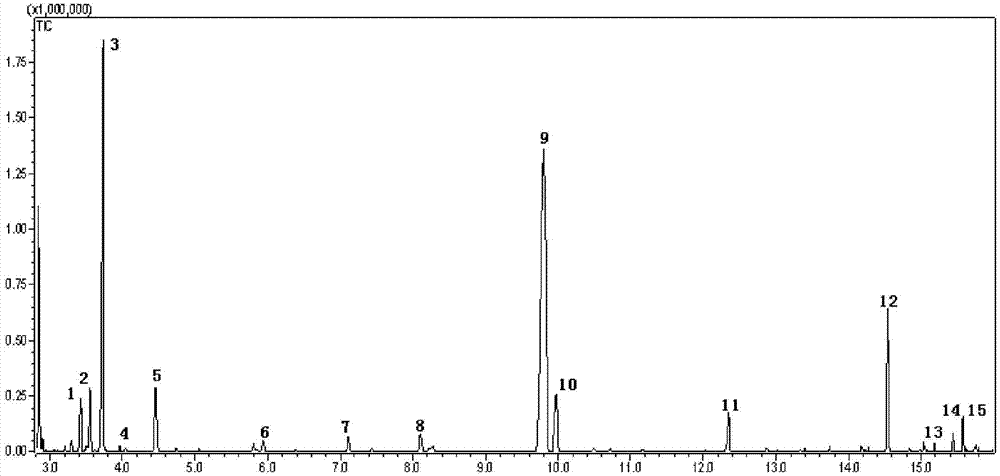Method for detecting organic acid, amino acid and sugar in fermented liquid by gas chromatography-mass spectrometry
A gas chromatography and mass spectrometry detection technology, which is applied to measurement devices, instruments, scientific instruments, etc., can solve the problems of narrow detection range, high test cost, low sensitivity, etc., and achieve the effect of saving time, excellent extraction effect and simplifying operation steps.
- Summary
- Abstract
- Description
- Claims
- Application Information
AI Technical Summary
Problems solved by technology
Method used
Image
Examples
Embodiment 1
[0023] Take the Clostridium fermentation broth.
[0024] (1) Sample preparation of intracellular metabolites: Take 5ml of fermentation broth, centrifuge to obtain the bacteria, wash the bacteria twice with normal saline, dissolve in cold methanol at -40°C, and the dry weight of the biomass reaches 0.8g / ml, and ultrasonically break down to the cells Cleavage to obtain a lysate, extract the lysate at low temperature, the low temperature condition is: extract at -40°C to -50°C for 2 hours, centrifuge to collect 50ul of the extracted lysate supernatant I, add internal standard ribitol solution, and lyse the supernatant I The ratio of the volume to the weight of the internal standard ribitol is 50ul:20μg, and vacuum-dried at room temperature to obtain the intracellular metabolite sample I.
[0025] (2) Preparation of extracellular fluid samples: take fermentation broth and centrifuge to obtain supernatant II, take 200ul supernatant II, add acetonitrile to supernatant II to remove p...
Embodiment 2
[0030] Get the lactic acid bacteria fermentation liquid.
[0031] (1) Sample preparation of intracellular metabolites: Take 5ml of fermentation broth, centrifuge to obtain the bacteria, wash the bacteria three times with normal saline, dissolve in cold methanol at -40°C, and the dry weight of the biomass reaches 1.0g / ml, and ultrasonically break down to the cells Cleavage to obtain a lysate, extract the lysate at low temperature, the low temperature conditions are: extract at -40°C to -50°C for 5 hours, centrifuge to collect 100ul of the extracted lysate supernatant I, add internal standard ribitol solution, and lyse the supernatant I The ratio of the volume to the weight of the internal standard ribitol is 100ul:20μg, and vacuum-dried at room temperature to obtain the intracellular metabolite sample I.
[0032](2) Preparation of extracellular fluid samples: take the fermentation broth, centrifuge to obtain supernatant II, take 350ul of supernatant II, add acetonitrile to supe...
Embodiment 3
[0036] Take the mold fermentation broth.
[0037] (1) Sample preparation of intracellular metabolites: Take 5ml of fermentation broth, centrifuge to obtain the bacteria, wash the bacteria three times with normal saline, dissolve in cold methanol at -40°C, and the dry weight of the biomass reaches 0.6g / ml, and ultrasonically break down to the cells Cleavage to obtain a lysate, extract the lysate at low temperature, the low temperature condition is: extract at -40°C to -50°C for 3 hours, centrifuge to collect 200ul of the extracted lysate supernatant I, add internal standard ribitol solution, and lyse the supernatant I The ratio of the volume to the weight of the internal standard ribitol is 200ul:20μg, and vacuum-dried at room temperature to obtain the intracellular metabolite sample I.
[0038] (2) Preparation of extracellular fluid samples: take the fermentation broth, centrifuge to obtain supernatant II, take 60ul of supernatant II, add acetonitrile to supernatant II to remo...
PUM
 Login to View More
Login to View More Abstract
Description
Claims
Application Information
 Login to View More
Login to View More - R&D
- Intellectual Property
- Life Sciences
- Materials
- Tech Scout
- Unparalleled Data Quality
- Higher Quality Content
- 60% Fewer Hallucinations
Browse by: Latest US Patents, China's latest patents, Technical Efficacy Thesaurus, Application Domain, Technology Topic, Popular Technical Reports.
© 2025 PatSnap. All rights reserved.Legal|Privacy policy|Modern Slavery Act Transparency Statement|Sitemap|About US| Contact US: help@patsnap.com

